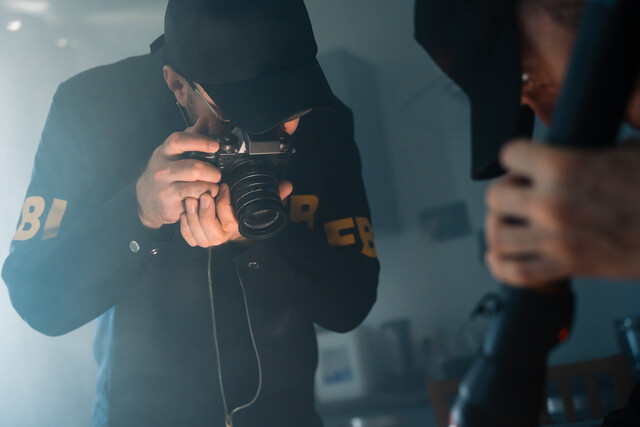Online Class: Fashion Design 101 — An Introduction

-
11Lessons
-
18Exams &
Assignments -
6Hours
average time -
0.6CEUs
Course Description
Have you ever dreamed of creating designs that inspire, captivate, and define the way people express themselves? Fashion isn't just about clothing-it's a language, an art form, and a business that shapes culture and transforms lives. Fashion Design 101 is more than a course-it's your gateway to becoming a true innovator in one of the world's most dynamic industries.
Imagine stepping into a world where your ideas come to life, where the sketches on your notepad evolve into stunning collections that turn heads and tell stories. This course is your blueprint for mastering not only the artistry but also the strategy behind fashion. It's designed to immerse you in the essentials of design, fabrics, colors, and patterns while revealing the often-hidden realities of the fashion industry. From haute couture to accessible everyday wear, you'll gain an unparalleled understanding of what it takes to succeed.
What sets Fashion Design 101 apart is its unique blend of creativity and practicality. You won't just learn how to design; you'll uncover how to think like a designer. Through an engaging exploration of the techniques and principles behind fabric selection, color coordination, and garment construction, you'll build the skills that make fashion come alive. But that's only the beginning. This course also dives into the business of fashion-because being a designer today means mastering the balance between artistry and entrepreneurship.
Whether you're a student, a seamstress, or someone with an unshakable passion for fashion, this course is tailored to ignite your potential. It's for those who dream big, think boldly, and are ready to take the first step toward a career that combines creativity with purpose. You'll discover the hidden pathways of the industry, from styling and illustration to merchandising and production, equipping you to wear every hat a designer needs.
By the time you complete Fashion Design 101, you'll have the foundation to not only design but to innovate. You'll see fashion through a new lens-one where every detail matters, every decision has impact, and every design tells a story. Your story.
Don't just follow trends-create them. Take the leap, and let Fashion Design 101 be your first step toward a future in fashion that's as unique and extraordinary as you are.
- Business
- Business Ethics Courses
- Harassment Prevention Courses
- Human Resources Certifications
- Management
- Aromatherapy Courses
- Caregiver Courses
- Career Development Courses
- Communications Courses
- Confidence and Self Esteem Courses
- Healing
- Human Anatomy Courses
- Medical Skills
- Health & Medicine
- Nutrition
- Marketing
- Microsoft Office Certification Courses
- Life Coaching Courses
- Self-Improvement
- Small Business Certifications
- Safety
- Writing Improvement
- Business Writing Courses
Course Lessons
Lesson 1. The Creative Path: Becoming a Fashion Designer
 Lesson 1 Video
Lesson 1 Video Review Practice Worksheet: Lesson-1-Activity-10522.pdf
Review Practice Worksheet: Lesson-1-Activity-10522.pdf Lesson discussions: Reasons for Taking this Course
Lesson discussions: Reasons for Taking this Course Complete Assignment: An Introduction
Complete Assignment: An Introduction Assessment: Lesson 1 Review Exam
Assessment: Lesson 1 Review Exam
Lesson 2. Mastering the Fashion Design Maze: Your Path to Success
 Lesson 2 Video
Lesson 2 Video Review Practice Worksheet: Lesson-2-Activity-10524.pdf
Review Practice Worksheet: Lesson-2-Activity-10524.pdf Assessment: Lesson 2 Review Exam
Assessment: Lesson 2 Review Exam
Lesson 3. Fashion's Visual Language: The Power of Accessories
 Lesson 3 Video
Lesson 3 Video Review Practice Worksheet: Lesson-3-HomeWork-10526.pdf
Review Practice Worksheet: Lesson-3-HomeWork-10526.pdf Assessment: Lesson 3 Review Exam
Assessment: Lesson 3 Review Exam
Lesson 4. The Journey of Manufacturing: An Intricate Ballet of Innovation
 Lesson 4 Video
Lesson 4 Video Review Practice Worksheet: Lesson-4-WordSearch-10528.pdf
Review Practice Worksheet: Lesson-4-WordSearch-10528.pdf Complete: Lesson 4 Activity
Complete: Lesson 4 Activity Assessment: Lesson 4 Review Exam
Assessment: Lesson 4 Review Exam
Lesson 5. The Power of Color: Influence and Significance Across Cultures
 Lesson 5 Video
Lesson 5 Video Review Practice Worksheet: Lesson-5-Downloadable-10530.pdf
Review Practice Worksheet: Lesson-5-Downloadable-10530.pdf Assessment: Lesson 5 Review Exam
Assessment: Lesson 5 Review Exam
Lesson 6. The Fabric of Fashion: Mastering Cloth Crafting in Design
 Lesson 6 Video
Lesson 6 Video Review Practice Worksheet: Lesson-6-WorkSheet-10532.pdf
Review Practice Worksheet: Lesson-6-WorkSheet-10532.pdf Complete: Lesson 6 Activity
Complete: Lesson 6 Activity Assessment: Lesson 6 Review Exam
Assessment: Lesson 6 Review Exam
Lesson 7. Express Your Story Through Fashion
 Lesson 7 Video
Lesson 7 Video Review Practice Worksheet: Lesson-7-WordSearch-10534.pdf
Review Practice Worksheet: Lesson-7-WordSearch-10534.pdf Complete: Lesson 7 Activity
Complete: Lesson 7 Activity Assessment: Lesson 7 Review Exam
Assessment: Lesson 7 Review Exam
Lesson 8. Fashion Design Project Essentials
 Lesson 8 Video
Lesson 8 Video Review Practice Worksheet: Lesson-8-HomeWork-10536.pdf
Review Practice Worksheet: Lesson-8-HomeWork-10536.pdf Complete: Lesson 8 Activity
Complete: Lesson 8 Activity Assessment: Lesson 8 Review Exam
Assessment: Lesson 8 Review Exam
Lesson 9. From Dream to Runway: Your Guide to Launching a Fashion Brand
 Lesson 9 Video
Lesson 9 Video Review Practice Worksheet: Lesson-9-Activity-10538.pdf
Review Practice Worksheet: Lesson-9-Activity-10538.pdf Assessment: Lesson 9 Review Exam
Assessment: Lesson 9 Review Exam
Lesson 10. Fashion Marketing 101
 Lesson 10 Video
Lesson 10 Video Review Practice Worksheet: Lesson-10-WorkSheet-10540.pdf
Review Practice Worksheet: Lesson-10-WorkSheet-10540.pdf Complete: Lesson 10 Activity
Complete: Lesson 10 Activity Assessment: Lesson 10 Review Exam
Assessment: Lesson 10 Review Exam
Lesson 11. Mastering the Art and Science of Fashion Pricing
 Lesson 11 Video
Lesson 11 Video Review Practice Worksheet: Lesson-11-Downloadable-10542.pdf
Review Practice Worksheet: Lesson-11-Downloadable-10542.pdf Lesson discussions: Let us know what you think of this course; Program Evaluation Follow-up Survey (End of Course); Course Comments; Reasons for Taking this Course
Lesson discussions: Let us know what you think of this course; Program Evaluation Follow-up Survey (End of Course); Course Comments; Reasons for Taking this Course Complete: Lesson 11 Activity
Complete: Lesson 11 Activity Assessment: The Final Exam
Assessment: The Final Exam
Learning Outcomes
- Demonstrate the use of innovative techniques and materials in creating a sustainable fashion collection.
- Define the impact of historical fashion movements on the evolution of contemporary design aesthetics.
- Demonstrate understanding of different fashion career pathways by comparing the demands and opportunities between haute couture and mass market segments.
- Recognize the dynamics of self-employment in fashion design by identifying the role of technology and target demographics in establishing a successful brand.
- Demonstrate understanding of the historical and cultural significance of fashion accessories by identifying key influences in their design and use.
- Recognize how fashion accessories can elevate an outfit by analyzing their impact on an ensemble's overall appearance.
- Analyze the impact of collaboration between designers and manufacturers in optimizing production efficiency, using examples from modern fashion industry practices.
- Define the historical evolution of manufacturing from traditional to modern methods, citing specific technological innovations that have transformed the industry.
- Demonstrate an understanding of color associations across different cultures and how they influence design choices in fashion and marketing.
- Identify and apply key color terminology and systems, such as the Pantone Professional Color System, to ensure precise communication and reproduction in textile design.
- Demonstrate the ability to operate an overlocker by successfully completing at least one garment with clean, finished seams.
- Identify and explain the function of key fashion design equipment, including sewing machines, dress forms, and pattern-cutting tables, with 85% accuracy.
- Recognize and articulate the importance of creativity and individual expression in fashion design by creating a unique portfolio that highlights bold, innovative designs.
- Demonstrate mastery of lesson content at levels of 70% or higher.
Additional Course Information

- Document Your Lifelong Learning Achievements
- Earn an Official Certificate Documenting Course Hours and CEUs
- Verify Your Certificate with a Unique Serial Number Online
- View and Share Your Certificate Online or Download/Print as PDF
- Display Your Certificate on Your Resume and Promote Your Achievements Using Social Media

Student Testimonials
- "Participating in this course accomplished my personal goal, which was to jump-start myself into thinking analytically about fashion and about what I want to accomplish as a person-who-designs-for-myself, rather than staring blankly at the pattern books at Joann." -- Wende F.
- "All of it was helpful. This was new information for me." -- Cathy K.
- "All lessons were helpful and the instructor was very knowledgeable." -- Shekhar R.
Related Courses
-
 5 hours
0.5 CEUs
Lawful Employee Termination
+ More Info
5 hours
0.5 CEUs
Lawful Employee Termination
+ More Info
-
 7 hours
0.7 CEUs
History's Greatest Conspiracies
+ More Info
7 hours
0.7 CEUs
History's Greatest Conspiracies
+ More Info
-
 3 hours
0.3 CEUs
Criminology: The Anatomy of American Justice
+ More Info
3 hours
0.3 CEUs
Criminology: The Anatomy of American Justice
+ More Info
-
 7 hours
0.7 CEUs
Introduction to Logic
+ More Info
7 hours
0.7 CEUs
Introduction to Logic
+ More Info
-
 9 hours
0.9 CEUs
ABCs of Technical Writing
+ More Info
9 hours
0.9 CEUs
ABCs of Technical Writing
+ More Info
-
 7 hours
0.7 CEUs
Negotiation Skills
+ More Info
7 hours
0.7 CEUs
Negotiation Skills
+ More Info
-
 8 hours
0.8 CEUs
Restaurant Management Mastery
+ More Info
8 hours
0.8 CEUs
Restaurant Management Mastery
+ More Info
-
 7 hours
0.7 CEUs
Lifetime Wellness 101
+ More Info
7 hours
0.7 CEUs
Lifetime Wellness 101
+ More Info
-
 6 hours
0.6 CEUs
Cryptozoology 101
+ More Info
6 hours
0.6 CEUs
Cryptozoology 101
+ More Info
-
 7 hours
0.7 CEUs
Buying and Selling Antiques and Collectibles
+ More Info
7 hours
0.7 CEUs
Buying and Selling Antiques and Collectibles
+ More Info
-
 5 hours
0.5 CEUs
Writing the Great American Short Story
+ More Info
5 hours
0.5 CEUs
Writing the Great American Short Story
+ More Info
-
 6 hours
0.6 CEUs
Computer Literacy Level 2 - Internet Basics
+ More Info
6 hours
0.6 CEUs
Computer Literacy Level 2 - Internet Basics
+ More Info
-
 5 hours
0.5 CEUs
Constructive Feedback and Criticism
+ More Info
5 hours
0.5 CEUs
Constructive Feedback and Criticism
+ More Info





